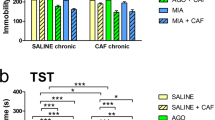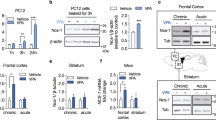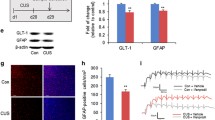Abstract
Caffeine prophylactically prevents mood and memory impairments through adenosine A2A receptor (A2AR) antagonism. A2AR antagonists also therapeutically revert mood and memory impairments, but it is not known if caffeine is also therapeutically or only prophylactically effective. Since depression is accompanied by mood and memory alterations, we now explored if chronic (4 weeks) caffeine consumption (0.3 g/L) reverts mood and memory impairment in helpless mice (HM, 12 weeks old), a bred-based model of depression. HM displayed higher immobility in the tail suspension and forced swimming tests, greater anxiety in the elevated plus maze, and poorer memory performance (modified Y-maze and object recognition). HM also had reduced density of synaptic (synaptophysin, SNAP-25), namely, glutamatergic (vGluT1; −22 ± 7 %) and GABAergic (vGAT; −23 ± 8 %) markers in the hippocampus. HM displayed higher A2AR density (72 ± 6 %) in hippocampal synapses, an enhanced facilitation of hippocampal glutamate release by the A2AR agonist, CGS21680 (30 nM), and a larger LTP amplitude (54 ± 8 % vs. 21 ± 5 % in controls) that was restored to control levels (30 ± 10 %) by the A2AR antagonist, SCH58261 (50 nM). Notably, caffeine intake reverted memory deficits and reverted the loss of hippocampal synaptic markers but did not affect helpless or anxiety behavior. These results reinforce the validity of HM as an animal model of depression by showing that they also display reference memory deficits. Furthermore, caffeine intake selectively reverted memory but not mood deficits displayed by HM, which are associated with an increased density and functional impact of hippocampal A2AR controlling synaptic glutamatergic function.





Similar content being viewed by others
Abbreviations
- A2AR:
-
Adenosine A2A receptor
- ADA:
-
Adenosine deaminase
- BrdU:
-
5-Bromo-2′-deoxyuridine
- CADO:
-
2-Chloroadenosine
- CGS21680:
-
4-[2-[[6-amino-9-(N-ethyl-β-D-ribofuranuronamidosyl)-9H-purin-2-yl]amino]ethyl]benzene propanoic acid
- DPCPX:
-
1,3-Dipropyl-8-cyclopentylxanthine
- fEPSPs:
-
Field excitatory post-synaptic potentials
- FR:
-
Fractional release
- HM:
-
Helpless mice
- LTP:
-
Long-term potentiation
- NHM:
-
Non-helpless mice
- PSD95:
-
Post-synaptic density 95 kDa
- SCH58261:
-
{7-(2-phenylethyl)-5-amino-2-(2-furyl)-pyrazolo-[4,3-e]-1,2,4-triazolol[1,5c]pyrimidine
- SNAP25:
-
Synaptosomal-associated protein 25 kDa
- vGAT:
-
Vesicular GABA transporters
- vGluT1:
-
Vesicular glutamate transporter type 1
References
Andlin-Sobocki P, Jönsson B, Wittchen HU, Olesen J (2005) Cost of disorders of the brain in Europe. Eur J Neurol 12(Suppl 1):1–27
Diener C, Kuehner C, Brusniak W, Ubl B, Wessa M, Flor H (2012) A meta-analysis of neurofunctional imaging studies of emotion and cognition in major depression. NeuroImage 61:677–685
Price JL, Drevets WC (2012) Neural circuits underlying the pathophysiology of mood disorders. Trends Cogn Sci 16:61–71
Kim JJ, Diamond DM (2002) The stressed hippocampus, synaptic plasticity and lost memories. Nat Rev Neurosci 3:453–462
Clark L, Chamberlain SR, Sahakian BJ (2009) Neurocognitive mechanisms in depression: implications for treatment. Annu Rev Neurosci 32:57–74
de Kloet ER, Joëls M, Holsboer F (2005) Stress and the brain: from adaptation to disease. Nat Rev Neurosci 6:463–475
McEwen BS (2007) Physiology and neurobiology of stress and adaptation: central role of the brain. Physiol Rev 87:873–904
Coleman P, Federoff H, Kurlan R (2004) A focus on the synapse for neuroprotection in Alzheimer disease and other dementias. Neurology 63:1155–1162
Wishart TM, Parson SH, Gillingwater TH (2006) Synaptic vulnerability in neurodegenerative disease. J Neuropathol Exp Neurol 65:733–739
Cunha RA, Agostinho PM (2010) Chronic caffeine consumption prevents memory disturbance in different animal models of memory decline. J Alzheimers Dis 20(Suppl 1):95–116
Duman RS, Aghajanian GK (2012) Synaptic dysfunction in depression: potential therapeutic targets. Science 338:68–72
Fredholm BB, Chen JF, Cunha RA, Svenningsson P, Vaugeois JM (2005) Adenosine and brain function. Int Rev Neurobiol 63:191–270
Cunha RA (2008) Different cellular sources and different roles of adenosine: A1 receptor-mediated inhibition through astrocytic-driven volume transmission and synapse-restricted A2A receptor-mediated facilitation of plasticity. Neurochem Int 52:65–72
Fredholm BB, Battig K, Holmen J, Nehlig A, Zvartau EE (1999) Actions of caffeine in the brain with special reference to factors that contribute to its widespread use. Pharmacol Rev 51:83–133
Santos C, Costa J, Santos J, Vaz-Carneiro A, Lunet N (2010) Caffeine intake and dementia: systematic review and meta-analysis. J Alzheimers Dis 20(Suppl 1):S187–S204
Lucas M, Mirzaei F, Pan A, Okereke OI, Willett WC, O’Reilly ÉJ et al (2011) Coffee, caffeine, and risk of depression among women. Arch Intern Med 171:1571–1578
Arendash GW, Schleif W, Rezai-Zadeh K, Jackson EK, Zacharia LC, Cracchiolo JR et al (2006) Caffeine protects Alzheimer’s mice against cognitive impairment and reduces brain beta-amyloid production. Neuroscience 142:941–952
Dall’Igna OP, Fett P, Gomes MW, Souza DO, Cunha RA, Lara DR (2007) Caffeine and adenosine A2a receptor antagonists prevent beta-amyloid (25–35)-induced cognitive deficits in mice. Exp Neurol 203:241–245
Espinosa J, Rocha A, Nunes F, Costa MS, Schein V, Kazlauckas V et al (2013) Caffeine consumption prevents memory impairment, neuronal damage, and adenosine A2A receptors upregulation in the hippocampus of a rat model of sporadic dementia. J Alzheimers Dis 34:509–518
Laurent C, Eddarkaoui S, Derisbourg M, Leboucher A, Demeyer D, Carrier S et al (2014) Beneficial effects of caffeine in a transgenic model of Alzheimer’s disease-like tau pathology. Neurobiol Aging 35:2079–2090
Pechlivanova DM, Tchekalarova JD, Alova LH, Petkov VV, Nikolov RP, Yakimova KS (2012) Effect of long-term caffeine administration on depressive-like behavior in rats exposed to chronic unpredictable stress. Behav Pharmacol 23:339–347
Kaster MP, Machado NJ, Silva HB, Nunes A, Ardais AP, Santana M et al (2015) Caffeine acts through neuronal adenosine A2A receptors to prevent mood and memory dysfunction triggered by chronic stress. Proc Natl Acad Sci U S A 112:7833–7838
Cunha GM, Canas PM, Melo CS, Hockemeyer J, Müller CE, Oliveira CR et al (2008) Adenosine A2A receptor blockade prevents memory dysfunction caused by β-amyloid peptides but not by scopolamine or MK-801. Exp Neurol 210:776–781
Canas PM, Porciúncula LO, Cunha GMA, Silva CG, Machado NJ, Oliveira JM et al (2009) Adenosine A2A receptor blockade prevents synaptotoxicity and memory dysfunction caused by β-amyloid peptides via p38 mitogen-activated protein kinase pathway. J Neurosci 29:14741–14751
Batalha VL, Pego JM, Fontinha BM, Costenla AR, Valadas JS, Baqi Y et al (2013) Adenosine A2A receptor blockade reverts hippocampal stress-induced deficits and restores corticosterone circadian oscillation. Mol Psychiatry 18:320–331
Laurent C, Burnouf S, Ferry B, Batalha VL, Coelho JE, Baqi Y et al (2015) A2A adenosine receptor deletion is protective in a mouse model of Tauopathy. Mol Psychiatry 21:97–107
Li P, Rial D, Canas PM, Yoo JH, Li W, Zhou X et al (2015) Optogenetic activation of intracellular adenosine A2A receptor signaling in the hippocampus is sufficient to trigger CREB phosphorylation and impair memory. Mol Psychiatry 20:1339–1349
Pagnussat N, Almeida AS, Marques DM, Nunes F, Chenet GC, Botton PH et al (2015) Adenosine A2A receptors are necessary and sufficient to trigger memory impairment in adult mice. Br J Pharmacol 172:3831–3845
Coelho JE, Alves P, Canas PM, Valadas JS, Shmidt T, Batalha VL et al (2014) Overexpression of adenosine A2A receptors in rats: effects on depression, locomotion, and anxiety. Front Psychol 5:67
Rebola N, Rodrigues RJ, Lopes LV, Richardson PJ, Oliveira CR, Cunha RA (2005) Adenosine A1 and A2A receptors are co-expressed in pyramidal neurons and co-localized in glutamatergic nerve terminals of the rat hippocampus. Neuroscience 133:79–83
Rebola N, Lujan R, Cunha RA, Mulle C (2008) Adenosine A2A receptors are essential for long-term potentiation of NMDA-EPSCs at hippocampal mossy fiber synapses. Neuron 57:121–134
Costenla AR, Diógenes MJ, Canas PM, Rodrigues RJ, Nogueira C, Maroco J et al (2011) Enhanced role of adenosine A2A receptors in the modulation of LTP in the rat hippocampus upon ageing. Eur J Neurosci 34:12–21
Cunha GM, Canas PM, Oliveira CR, Cunha RA (2006) Increased density and synapto-protective effect of adenosine A2A receptors upon sub-chronic restraint stress. Neuroscience 141:1775–1781
Silva CG, Porciúncula LO, Canas PM, Oliveira CR, Cunha RA (2007) Blockade of adenosine A2A receptors prevents staurosporine-induced apoptosis of rat hippocampal neurons. Neurobiol Dis 27:182–189
El Yacoubi M, Bouali S, Popa D, Naudon L, Leroux-Nicollet I, Hamon M et al (2003) Behavioral, neurochemical, and electrophysiological characterization of a genetic mouse model of depression. Proc Natl Acad Sci U S A 100:6227–6232
El Yacoubi M, Popa D, Martin B, Zimmer L, Hamon M, Adrien J et al (2011) Genetic association between helpless trait and depression-related phenotypes: evidence from crossbreeding studies with H/Rouen and NH/Rouen mice. Int J Neuropsychopharmacol 3:1–12
Bougarel L, Guitton J, Zimmer L, Vaugeois JM, El Yacoubi M (2011) Behaviour of a genetic mouse model of depression in the learned helplessness paradigm. Psychopharmacology 215:595–605
Cognato GP, Agostinho PM, Hockemeyer J, Müller CE, Souza DO, Cunha RA (2010) Caffeine and adenosine A2A receptor antagonists prevent memory impairment and synaptotoxicity in adult rats triggered by a convulsive episode in early life. J Neurochem 112:453–462
Duarte JM, Agostinho PM, Carvalho RA, Cunha RA (2012) Caffeine consumption prevents diabetes-induced memory impairment and synaptotoxicity in the hippocampus of NONcZNO10/LTJ mice. PLoS ONE 7, e21899
Carreira BP, Morte MI, Inácio Â, Rosmaninho-Salgado J, Costa G, Agasse F et al (2010) Nitric oxide stimulates the proliferation of neural stem cells bypassing the epidermal growth factor receptor. Stem Cells 28:1219–1230
Anderson WW, Collingridge GL (2001) The LTP Program: a data acquisition program for on-line analysis of long-term potentiation and other synaptic events. J Neurosci Methods 108:71–83
Köfalvi A, Pereira MF, Rebola N, Rodrigues RJ, Oliveira CR, Cunha RA (2007) Anandamide and NADA bi-directionally modulate presynaptic Ca2+ levels and transmitter release in the hippocampus. Br J Pharmacol 151:551–563
Scheff SW, Price DA, Schmitt FA, Mufson EJ (2006) Hippocampal synaptic loss in early Alzheimer’s disease and mild cognitive impairment. Neurobiol Aging 27:1372–1384
Warner-Schmidt JL, Duman RS (2006) Hippocampal neurogenesis: opposing effects of stress and antidepressant treatment. Hippocampus 16:239–249
Coelho JE, Rebola N, Fragata I, Ribeiro JA, de Mendonça A, Cunha RA (2006) Hypoxia-induced desensitization and internalization of adenosine A1 receptors in the rat hippocampus. Neuroscience 138:1195–1203
MacMaster FP, Mirza Y, Szeszko PR, Kmiecik LE, Easter PC, Taormina SP et al (2008) Amygdala and hippocampal volumes in familial early onset major depressive disorder. Biol Psychiatry 63:385–390
Sheline YI, Sanghavi M, Mintun MA, Gado MH (1999) Depression duration but not age predicts hippocampal volume loss in medically healthy women with recurrent major depression. J Neurosci 19:5034–5043
Sarnyai Z, Sibille EL, Pavlides C, Fenster RJ, McEwen BS, Toth M (2000) Impaired hippocampal-dependent learning and functional abnormalities in the hippocampus in mice lacking serotonin(1A) receptors. Proc Natl Acad Sci U S A 97:14731–14736
Sahun I, Delgado-Garcia JM, Amador-Arjona A, Giralt A, Alberch J, Dierssen M et al (2007) Dissociation between CA3-CA1 synaptic plasticity and associative learning in TgNTRK3 transgenic mice. J Neurosci 27:2253–2260
Rutten K, Misner DL, Works M, Blokland A, Novak TJ, Santarelli L et al (2008) Enhanced long-term potentiation and impaired learning in phosphodiesterase 4D-knockout (PDE4D) mice. Eur J Neurosci 28:625–632
Rebola N, Sebastião AM, de Mendonça A, Oliveira CR, Ribeiro JA, Cunha RA (2003) Enhanced adenosine A2A receptor facilitation of synaptic transmission in the hippocampus of aged rats. J Neurophysiol 90:1295–1303
Prediger RD, Batista LC, Takahashi RN (2005) Caffeine reverses age-related deficits in olfactory discrimination and social recognition memory in rats. Involvement of adenosine A1 and A2A receptors. Neurobiol Aging 26:957–964
El Yacoubi M, Ledent C, Parmentier M, Bertorelli R, Ongini E, Costentin J et al (2001) Adenosine A2A receptor antagonists are potential antidepressants: evidence based on pharmacology and A2A receptor knockout mice. Br J Pharmacol 134:68–77
van Calker D, Biber K (2005) The role of glial adenosine receptors in neural resilience and the neurobiology of mood disorders. Neurochem Res 30:1205–1217
Acknowledgments
This work was supported by NARSAD, DARPA (09-68-ESR-FP-010), Fundação para a Ciência e para a Tecnologia (PTDC/SAU-NEU/122254/2010 and PEst-C/SAU/LA0001/2013-2014), QREN (CENTRO-07-ST24-FEDER-002006), program Égide-Pessoa, CAPES-FCT, and CAPES (Ciência sem Fronteiras).
Author information
Authors and Affiliations
Corresponding author
Additional information
Nuno J. Machado, Ana Patrícia Simões, Henrique B. Silva, Ana Paula Ardais, Manuella P. Kaster, Pedro Garção, Diana I. Rodrigues and Catarina A. Gomes contributed equally to this work.
Rights and permissions
About this article
Cite this article
Machado, N.J., Simões, A.P., Silva, H.B. et al. Caffeine Reverts Memory But Not Mood Impairment in a Depression-Prone Mouse Strain with Up-Regulated Adenosine A2A Receptor in Hippocampal Glutamate Synapses. Mol Neurobiol 54, 1552–1563 (2017). https://doi.org/10.1007/s12035-016-9774-9
Received:
Accepted:
Published:
Issue Date:
DOI: https://doi.org/10.1007/s12035-016-9774-9




